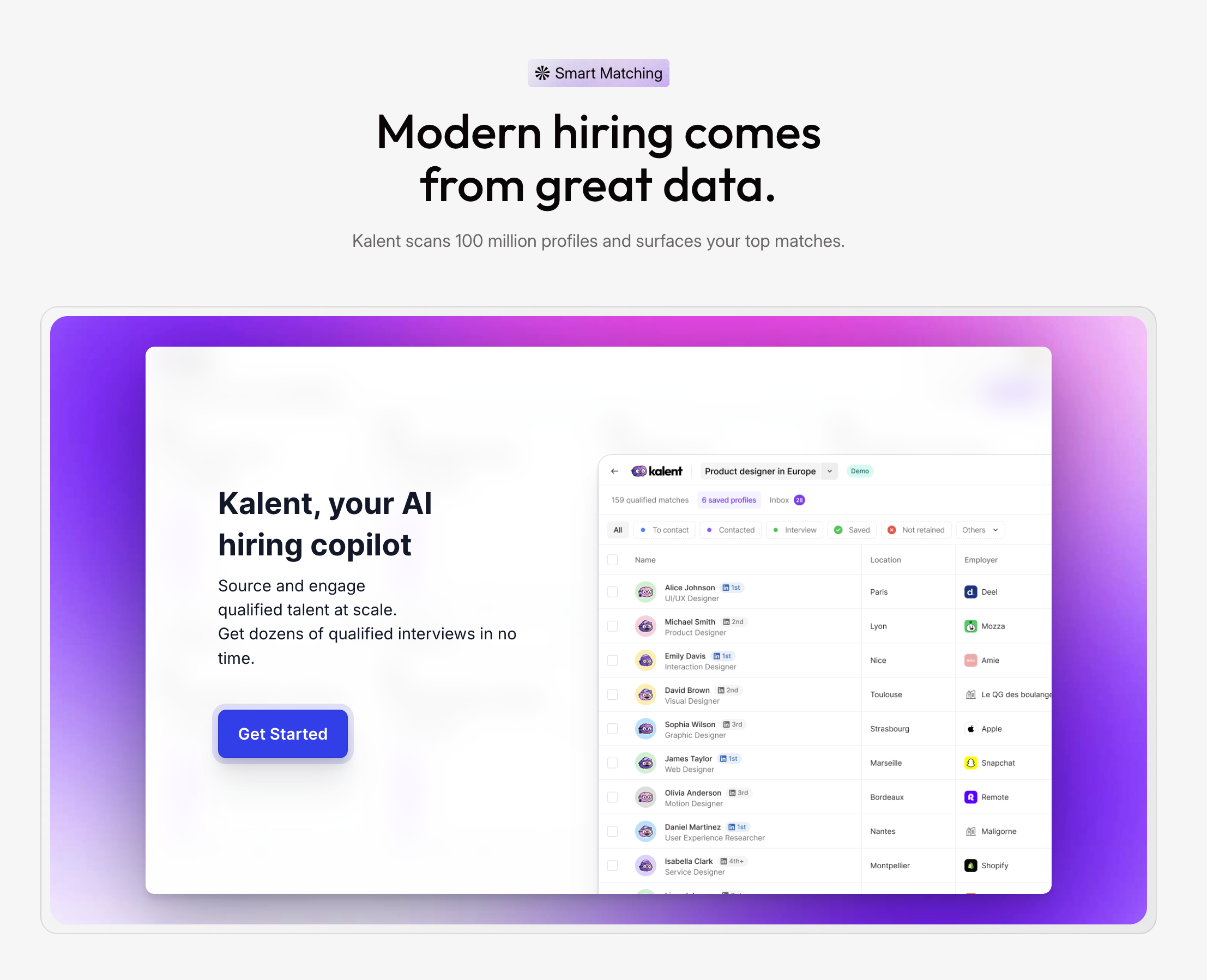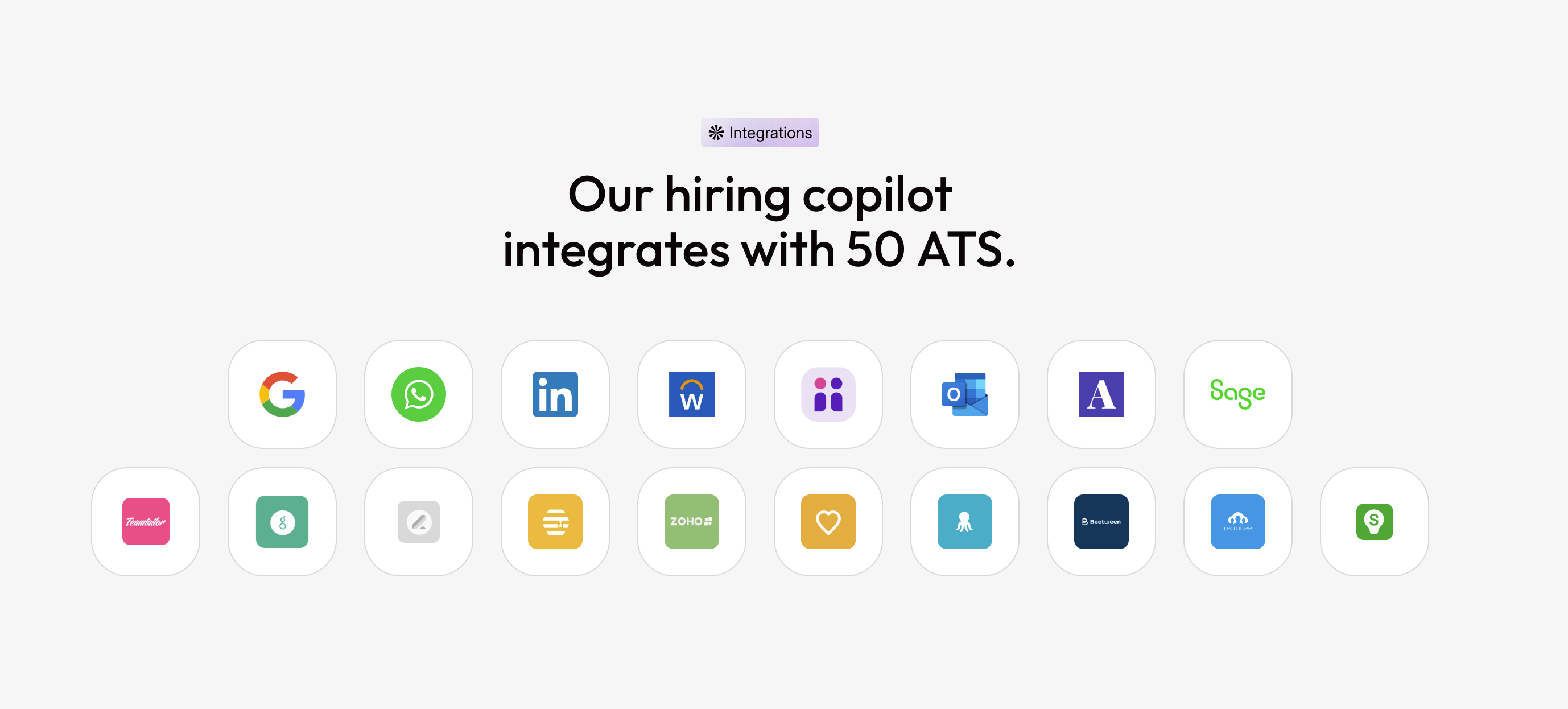What Are the Best Sourcing Tools for Recruiters in 2025? (Full List + Why Kalent Leads the Pack)
- Lists 2025’s best sourcing tools - Explains how AI transforms talent sourcing - Compares LinkedIn, HireEZ, AmazingHiring, Apollo, SeekOut - Shows what makes sourcing tools effective - Highlights Kalent as the sourcing leader - Kalent streamlines sourcing tools and talent sourcing
What Are the Best Sourcing Tools for Recruiters?
Before AI sourcing tools, finding candidates used to mean long afternoons trawling through LinkedIn, typing one Boolean string after another and sending connection requests into the void. It was tedious, manual and often unproductive.
Fast forward to 2025 and there’s no shortage of tools promising to change all that. The problem is that not all talent sourcing tools actually lead to better results, and some could actually be slowing you down or harming the quality of your outreach.
There’s no shortage of people looking for work in the US and overseas right now, but recruiters often struggle to find the right people at the right time. The role of a recruiter involves finding the perfect match for their client, engaging them in meaningful conversations, and doing it all without making mistakes or burning out.
It’s a tough job, but the right sourcing tools can make all the difference. Let’s look at some of the best platforms used by recruiters in 2025.
What’s So Great About Modern Sourcing Tools?
Sourcing tools used to be nothing more than glorified search engines, matching candidates based on basic keywords. Thanks to artificial intelligence, recruitment sourcing tools have evolved into intelligent systems that utilize machine learning to predict a good contextual fit, surface hidden talent and even craft tailored outreach messages.
The shift happened because the old way simply couldn’t keep up with the modern demands of recruiting. Manual searches were too slow for a hyper-competitive hiring market, and recruiters needed tools that could balance speed, accuracy and personalization all at once.
The challenge with these new AI tools is that if you move too fast, you can sacrifice the quality of your messaging – but personalize too much and you lose time.
This tension paved the way for AI copilots like Kalent – platforms that do the groundwork, pulling together context, data and outreach so recruiters can focus on building relationships instead of chasing profiles. And since candidates no longer exist in just one digital space, the best tools now reach across LinkedIn, GitHub, Slack, Twitter/X and beyond.

What Makes a Great Sourcing Tool in 2025?
Not all sourcing tools are built equally, so what should you look for when seeking out a talent sourcing co-pilot? Here’s some criteria to consider:
Accuracy
A smaller pool of verified, relevant candidates is worth more than a massive database full of stale contacts. When it comes to recruitment, quality beats quantity every time.
Compliance
GDPR and CCPA are table stakes now. In 2025, recruiters can’t afford to use data-shaky platforms, so compliance is a must-have.
Integration
If you’re still copying data between tools, your tech stack is slowing you down rather than helping you work more efficiently. The best platforms plug directly into your CRM or ATS and integrate easily with your other tools.
AI Intelligence
Smart AI tools can interpret GitHub activity, analyze social engagement and infer candidate intent to help you save time, get more accurate data and secure better matches.
Personalization At Scale
Generic, templated recruitment messages don’t work. The right sourcing will help you automate outreach without losing personalization or authenticity.

What Talent Sourcing Tools Do Recruiters Rely On in 2025?
LinkedIn Recruiter
LinkedIn is still the biggest name in the game when it comes to talent sourcing. With over 1 billion professional profiles, LinkedIn Recruiter remains the go-to for traditional searches – and for good reason. Its filters are deep, its reach is unmatched and InMail offers a direct line to candidates.
However, LinkedIn is also showing its age. The personalization tools are limited, and the user experience still feels quite manual. For small teams, the price tag can also be quite steep.
LinkedIn might be reliable, but it’s not the only sourcing tool you need if you’re focused on corporate or leadership roles.

HireEZ (formerly Hiretual)

HireEZ earned its reputation by casting a wide net, searching 45+ platforms simultaneously and enriching profiles with contact data. With this tool, you can manage pipelines, build Boolean strings and automate parts of your workflow.
Its data aggregation is impressive, but it’s not always the most accurate. Email enrichment can also be hit or miss, and the platform doesn’t fully solve outreach personalization.
HireEZ is a strong choice for technical or niche talent sourcing, especially if you rely heavily on email, but you’ll still need other tools to close the loop when it comes to general recruitment.
AmazingHiring

This tool is a firm favourite among tech recruiters. AmazingHiring digs through GitHub, Stack Overflow and Kaggle to find engineers based on their code, projects and community activity. It even maps connections between developers for warmer intros.
AmazingHiring is a niche tool, though, so if you’re not hiring in tech, it won’t add much value. It’s powerful within its lane, but not an end-to-end sourcing platform like Kalent.
Apollo.io

Apollo blurs the line between sales and recruiting, like a CRM and prospecting platform all in one. It’s great for volume-based outreach, with automated sequences, workflow automation, and lead scoring, and for recruiters who work like outbound specialists — tracking engagement, running campaigns and following up in bulk.
However, contact accuracy can be inconsistent, and it lacks the context-aware AI matching that recruiters now expect. Apollo is efficient, but it won’t deeply personalize your workflow or maintain that human touch that’s so vital to effective recruitment.
SeekOut

SeekOut focuses on diversity sourcing and data-driven insights. Its AI helps recruiters build balanced pipelines and analyze workforce trends.
The downside is that it's built for enterprise teams with resources to spare – meaning it’s pretty expensive and difficult to use. Smaller agencies often find SeekOut is overpowered for day-to-day sourcing, and it also stops short of managing actual engagement, which means recruiters still bounce between platforms.
Kalent

Kalent approaches sourcing differently. Instead of being another add-on tool, it acts as a full AI copilot, blending sourcing, engagement and context in one streamlined workspace.
It reads job descriptions, analyzes candidate profiles and even reviews past communication to craft tailored outreach that feels personal, not automated. The system learns from recruiter feedback, improving tone, timing and targeting as it goes.
Kalent’s multi-channel AI orchestration is another standout feature. It adapts across LinkedIn, Slack and other professional platforms based on candidate behaviour, preferences and geographical data.
Our context-aware messaging is designed to resonate with high-value candidates and skips over the generic “insert name here” messages that most job seekers ignore. The platform also merges CRM and sequencing tools into one place, meaning no more jumping between apps – you can find, qualify and engage candidates in a single flow.
Try Kalent Today!
Where most sourcing tools stop at search, Kalent completes the loop, helping you transform static data into dynamic, real-time engagement. It’s what happens when AI becomes an extension of your strategy, while keeping humans in the loop at every turn.
Book a demo today to see how our AI sourcing tool could streamline and improve your recruitment workflows.




